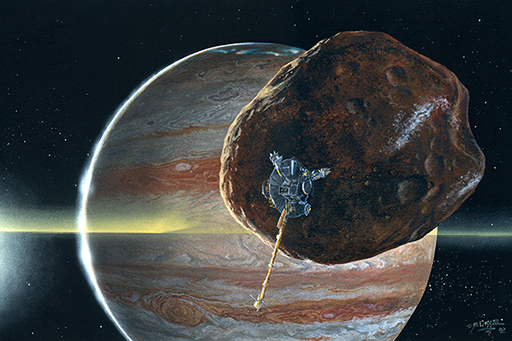1.5 The Galileo mission
Having flown past the giant planets and their satellites, the next logical step was to go into orbit about one of these planets, to allow a longer look (to observe changes) and more complete imaging (planetary flybys don’t allow you to see both sides of a moon in detail). Getting into orbit is more difficult than merely flying past, because you need to use rocket fuel to slow down and change your direction of travel. To maximise the number of instruments carried you need to save on fuel. With this in mind, mission planners these days usually arrange for their probe to fly past other planets on the way to their destination, to speed it on its way and to help it arrive at its destination from a direction that makes capture into orbit relatively inexpensive in terms of fuel.
Such was the plan for Galileo, the first probe to orbit Jupiter. It was meant to be sent into space by the Space Shuttle Atlantis in 1986 but the loss of the Space Shuttle Challenger earlier in the year delayed the launch until 1989.
Galileo’s gravity-assist trajectory took it past Venus in 1990, then twice past the Earth before flinging it outwards towards Jupiter. On the way, it made flybys of the first two asteroids to be seen at close quarters: Gaspra in 1991 and 243 Ida in 1993. Everyone was surprised when, several months later, a tiny moon of Ida, now named Dactyl, was spotted on images of Ida that had been awaiting processing. This was the first moon of an asteroid to be discovered. By now, a few others have been seen at close quarters, and as you saw in ‘The moons of asteroids’ video back in Week 3, several others are now known either from optical telescopes or from radar observations.
Galileo achieved orbit about Jupiter in 1995, and also sent a probe by parachute into Jupiter’s atmosphere. The orbital tour was a complex affair, with numerous adjustments to give as many close flybys of the large moons as possible. Just before manoeuvring fuel ran out, it was deliberately crashed into Jupiter in September 2003.
The amount of data, especially images, beamed back to Earth by Galileo was less than planned, because unfortunately its main parabolic antenna failed to deploy, with the result that all communications had to be via its small low-gain antenna. However, resourceful planning, use of data compression techniques, and the deployment of multiple antennas on Earth to listen for the weak signals from Galileo allowed most of the science goals to be achieved.
Headline moon discoveries by the Galileo mission include:
- Dactyl, the first known moon of an asteroid
- volcanic activity on Io tracked for several years
- images of Europa detailed enough to show the complexities of its surface, and magnetic field observations suggesting a salty ocean below its ice surface
- similar magnetic data suggesting salty oceans at greater depth below the surfaces of Ganymede and Callisto.
Galileo did not discover any new moons of Jupiter, but between 1999 and 2003, while Galileo was still active, ground-based observers used sensitive telescopes to locate no fewer than 34 previously unknown outer irregular moons of this gas giant.

Next, have a go at answering a question about why Galileo was crashed into Jupiter.
Activity 1 Why was Galileo deliberately crashed into Jupiter?
a.
So that its instruments could sample Jupiter’s cloud composition before contact was lost.
b.
Because to leave it in orbit about Jupiter would make it a hazard to future spacecraft.
c.
To remove any possibility of it one day crashing into Europa.
The correct answer is c.
c.
Correct. Given that Europa is potentially habitable, especially in the ocean below its surface ice, the mission controllers wanted to safeguard Europa from the remote chance of contamination by any microbes from Earth that might have been inadvertently carried by the orbiter, if one day when no longer under control, it accidentally crashed into Europa.
